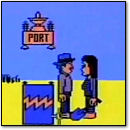[ Retro Scan of the Week ] Sega Interactive Comics
June 1st, 2015 by Benj EdwardsI’ve been intrigued by this Sega Electronic Comics System prototype since I first saw it in Popular Science’s What’s New section back in April 1995. Here is an excerpt from that very magazine.
As far as I know, this device never made it into production — in fact, the only mention I can find of it on the Internet as of this writing is this post on the Collectors Society forums.
Apparently, the Sega Electronic Comics device worked in conjunction with a tailor-made paper comic book that one would place onto the device. A series of pressure-sensitive buttons beneath the comic book could be pressed to somehow direct the narrative of the book. (Perhaps like Choose Your Own Adventure — i.e. if you do this, turn to page 3.)
This reminds me of the comic book device Tom Hanks’ character outlines in the film Big (1988), albeit without any type of electronic screen. The crazy thing is that 15 years after this Sega Prototype, you could buy an iPad that could store and display thousands of entirely digital comics in a much thinner form factor.
Discussion Topic of the Week: Do you use an electronic device to read comic books? Tell us about it.







June 1st, 2015 at 4:58 pm
I use my laptop, and the CDisplay reader program. Simple, basic, and so easy to use. My only digital comics are scans of comics from the 50-70s: Disney’s Scamp, Zorro, and UPA’s The Fox and the Crow. I don’t have the money or the patience to find and buy the original comics; not to mention I’d be terrified of degradation and making them unreadable.
I tried buying digital copies of Dark Horse’s “The Goon” but I got fed up with the restrictions and quickly went back to buying them in print after two digital copies.
June 5th, 2015 at 10:45 pm
Reminds me of the cartridges for the Pico (http://en.wikipedia.org/wiki/Sega_Pico) – wonder if it was based on it in some way?
June 6th, 2015 at 9:14 am
I haven’t read a comic book in a long time, however I can’t imagine this technology would’ve gained much interest in the US. I view this as a novelty item that could’ve only sold well in Japan because of the popularity of manga.
April 22nd, 2018 at 4:42 pm
They did make it, it’s called the Sega Pico. The book is attached to a cartridge, the cartridge plugs in like a video game, & the book rests against the tablet surface. The pages of the book have staggered notches cut out of the corner which cover light sensors on the tablet. So when you turn a page, one light sensor is uncovered & the television displays the screen that corresponds to the next page. The notch on the next page is cut out a little more & covers one fewer light sensors than the previous page. Using an attached magnetic pen, you touch any part of the page. The tablet underneath detects the position of the magnetic pen, the system knows which page you’re on, so if you’ve touched a picture at a location that triggers an interactive event for that page, something happens on the television screen. It’s kind of like the Wii U, since you’re looking down & then looking back up at the TV.
July 29th, 2019 at 11:43 am
Hi, I am the inventor along with Jay Smith Engineering and we sold this product to Tom Kalinske who was President of Sega of America and earlier, consultant on the “Big” movie. I was hired on as a Sr. Manager in the Sega Toy division from Mattel Toys.
I earlier presented the idea as a concept the would control the music volume and queues as you turn the page. This would give listeners that read comics the advantage of movie soundtracks tailored to the page. Jay and I expanded the interactivity by creating a touch grid similar to the LeapPad (Which was not yet invented) that allowed touch of page. The cartridges stored permutations of 3 games and sound effects based on interaction and outcome. There was discussion to adapt the technology to the PreSchool Market as well as a Pico book.
The PICO System was actually a Sega of Japan product with US game conversion and licensing. It was based on the old 16 bit Master System. This was all around 1992 to 1995